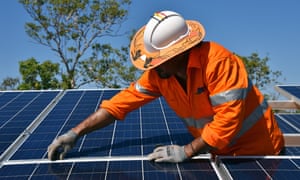Extract from The Guardian
Clean Energy Council warns surge ‘could come to an end if the energy policy debate is left to languish unresolved’
Australia’s renewables sector has doubled its output over the past 12
months, with more than $20bn of projects now under construction, but
the current boom will not last without policy certainty, according to
the Clean Energy Council.
The council, which represents solar, wind, energy efficiency, hydro, bioenergy, energy storage, geothermal and marine businesses, along with more than 5,000 solar installers, has released new figures claiming a record year for Australia’s renewables industry – with more than 80 wind and solar farms under construction, and rooftop solar installations now topping two million homes.
The CEC’s chief executive, Kane Thornton, said there were 14.6 gigawatts of new renewable energy projects under construction, which was equivalent to four times the energy output of the coal-fired Liddell power station, and the projects had created 13,000 jobs, including 4,500 in Queensland, 3,800 in Victoria and 2,100 in New South Wales.
“The skills and experience our industry has developed this decade now
allow new projects to be built more efficiently than ever before,
helping to push down projects’ costs and power prices,” Thornton said.The council, which represents solar, wind, energy efficiency, hydro, bioenergy, energy storage, geothermal and marine businesses, along with more than 5,000 solar installers, has released new figures claiming a record year for Australia’s renewables industry – with more than 80 wind and solar farms under construction, and rooftop solar installations now topping two million homes.
The CEC’s chief executive, Kane Thornton, said there were 14.6 gigawatts of new renewable energy projects under construction, which was equivalent to four times the energy output of the coal-fired Liddell power station, and the projects had created 13,000 jobs, including 4,500 in Queensland, 3,800 in Victoria and 2,100 in New South Wales.
“Along with the incentives provided by the renewable energy target (RET) and state policies, wind, solar and storage has created an extraordinary opportunity for thousands of people in regional parts of the country.”
But he said the positive trajectory was threatened by the continuing absence of a settled energy policy in Canberra. Thornton warned the renewables boom “could come to an end if the energy policy debate is left to languish unresolved”.
Thornton said the renewables sector was now sufficiently mature to not require subsidy, but it did require policy certainty.
“As the year closes, we are no closer to national, bipartisan energy and climate policy,” he said. “If anything, we are further away than when we started.
“States and territories have stepped in to fill the void with their own initiatives to encourage jobs and investment in new clean energy – but there remains a clear vacuum of federal energy policy in Australia.”
Energy stakeholders remain furious at the loss of the national energy guarantee, which was a casualty of the federal Liberal leadership change in August.
The energy minister, Angus Taylor, will meet his state counterparts next week in an attempt to implement the reliability component of the national energy guarantee, but the government has abandoned the emissions reduction component.
Labor says it will attempt to revive the policy if it wins the next federal election, with an emissions reduction target for electricity of 45%, rather than the Coalition’s proposal, which was 26%.

No comments:
Post a Comment